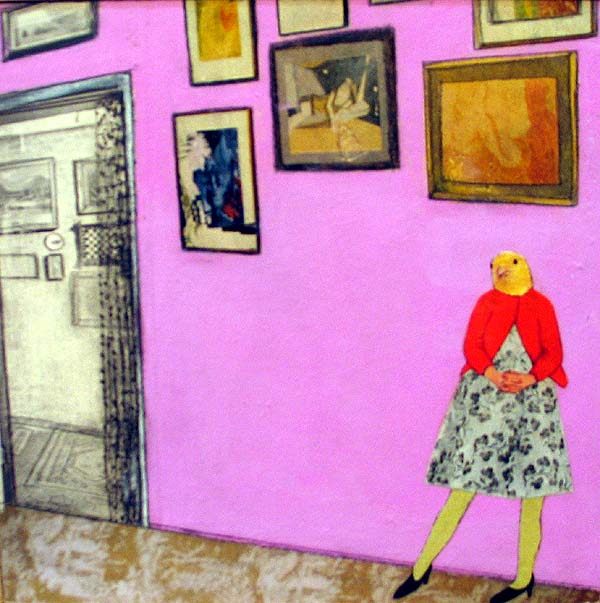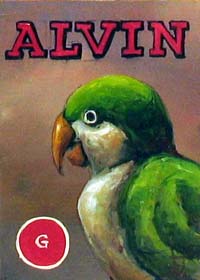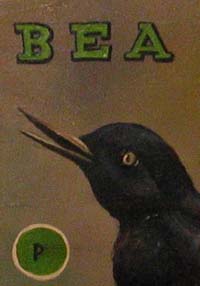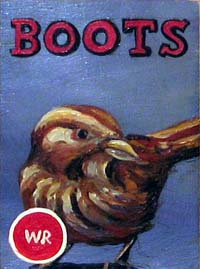Birds for Art Lovers: Bird x Bird Winter Show and Sale
Over at the Bell Museum of Natural History, theres a big traveling art exhibit for bird lovers. Thursday night at the Northrup King Building in Northeast Minneapolis, theres a modest, four-hour bird exhibit for art lovers. Chris Godsey explains.




At the Bell, “Birds in Art,” a globally prestigious wildlife art exhibition organized annually since 1976 by the Leigh Yawkey Woodson Art Museum, runs through Feb. 6 and features, according to the Woodson Web site, “the very best contemporary artistic interpretations of birds and related subject matter.”
In Northeast, the Bird x Bird Winter Exhibit and Sale—a 15-artist fundraiser for the group’s 2005 fall show–will run from 5-9 p.m. in Northrup King’s Gallery 351, at 1500 Jackson St. NE. According to a press release announcing the show, works will include “a wide selection of media and styles including paintings, mono prints, mixed media works, functional textiles and ceramics, as well as T-shirts and magnets and greeting cards.”
“This is the first time we’ve done a mid-season show,” said Bird x Bird Artistic Director Cynde Randall (who’s also a program associate to the Minnesota Artist Exhibition Program). “Some folks have produced work specifically for this show.” Others, she said, will exhibit work that didn’t sell at the group’s third annual auction, which included work by over 100 artists, last fall.
Bird x Bird, according to its Web site, “is a charitable organization linking art and science through exhibitions and programs that benefit wildlife and the environment. Its mission is to stimulate a creative interface between artists, scientists and the public in an effort to enhance the stewardship of wild species and the environmental education of human beings.”
Randall established the group in 2002 to raise money for the Minnesota Wildlife Haven, which treated orphaned and injured animals until it closed in 2004. She volunteered at MWH, and came up with the ambitious idea of organizing individual artistic tributes to the over 500 avian patients treated at the haven.
In the 2002 exhibition, 44 artists created works based on a handful of stipulations: each piece had to focus on a single bird and somehow include its species, its haven admittal number, and the date of its arrival. Randall said those conditions have been relaxed a bit for the winter exhibit and sale.
“This work won’t be linked as closely to the data as our fall show,” she said. “It’s more loosely bird-connected, but we’re still working to support a non-profit [Bird x Bird officially incorporated not long ago] that’s working to support avian and environmental education.”
Randall said even Bird x Bird artists who aren’t typically environmental or avian activists find inspiration in birds.
“I really think artists generally love birds,” she said. “A bird can take on so many layers. It can be a metaphor for flight, spirit or being. Lots of our artists are grappling with serious issues, not just having to do with the environment. Some of their work has been intense and dark—our shows aren’t like a wildlife show in any way, although some of the pieces are quite realistic.”
Bird x Bird artists Jennifer Davis and David Lefkowitz said that while they support the organization’s cause, their interest in birds is mostly artistic.
“Birds have just been showing up in my work for a few years,” said Davis. “Art is my main passion. I’ve definitely become interested in the cause because of all Cynde’s work. But for me it’s all about the art.”
Davis, who does “mostly collages, with acrylic on them,” said her work is “silly, cartoonish.” For Thursday’s exhibit and sale, she made about 25 refrigerator magnets that are miniature versions of her typical full-size works. “Each one is really different,” she said.
Lefkowitz, one of Bird x Bird’s original members, said he had “been supportive of a lot of general environmental organizations for a long time. I’m definitely supportive of this idea, but I had never supported it specifically.”
His most recent Bird x Bird work fits into a series of works that are in the size and rough style of trading cards—like baseball or hockey cards. “That way of drawing attention to something is interesting,” he said. “Isolating and dramatizing an individual’s identity. It seemed perfect for exploring and commenting on how we treat birds. It complicates how you treat them if they’re individualized and they get a name.
“On a technical level, this work has caused me to pay more attention to birds’ distinct features. I pay a lot of attention to what features distinguish one species from another, and to choices about angle and vantage point. A profile might read like a mug shot, for example. It can even go into conventions of how people are represented.”
Randall said there’s magic in combining art and science, “energy from the art world and environmental education and wildlife advocacy.”
“There’s no better time than now to be coming up with ideas that are beneficial to the world. Many people are lamenting the state of politics, the economy, the environment…there’s no better time for people to put our heads together and come up with responses to all that. Nature is always talking to us about the state of things. Artists are always talking about the state of things, too.”
Randall also said that while she appreciates the celebrated, expensive “Birds in Art” exhibit at the Bell, she’s “much more interested in staying connected to people and the earth.”
“I love that our event can be free,” she said. “Anyone who loves art and is interested in acquiring some of it will most likely be able to do so. It’s important that images that help us come together can be accessible—it’s important to keep the art scene accessible.”